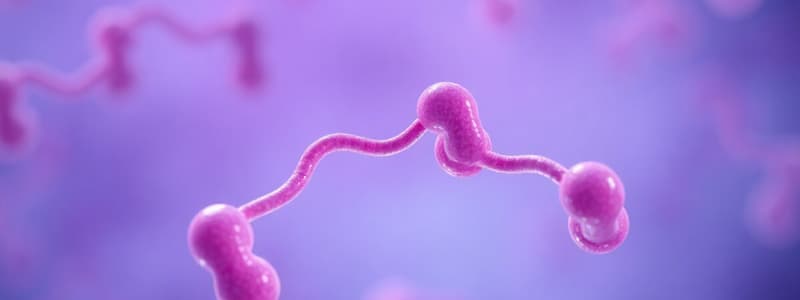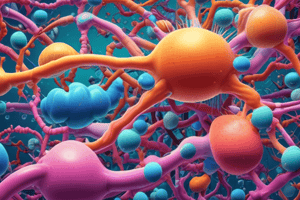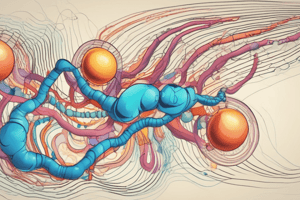Podcast
Questions and Answers
What type of transport allows lipids to move laterally within continuous membrane structures?
What type of transport allows lipids to move laterally within continuous membrane structures?
- Passive diffusion
- Facilitated transport
- ATP-dependent transport (correct)
- Vesicular transport
Which of the following organelles is a destination for lipids transported from the Smooth Endoplasmic Reticulum?
Which of the following organelles is a destination for lipids transported from the Smooth Endoplasmic Reticulum?
- Ribosomes
- Golgi apparatus (correct)
- Lysosomes
- Mitochondria
What characterizes the membranes that allow the lateral movement of lipids?
What characterizes the membranes that allow the lateral movement of lipids?
- They are not physically connected.
- They contain specific proteins for lipid transport.
- They are rigid and permanent structures.
- They are dynamic and continuously rearranging. (correct)
In the context of lipid transport, what does the term 'vesicular transport' primarily refer to?
In the context of lipid transport, what does the term 'vesicular transport' primarily refer to?
What process is essential for the transport of lipids to downstream organelles in the secretory pathway?
What process is essential for the transport of lipids to downstream organelles in the secretory pathway?
What does the polarity of the ER indicate about vesicular transport?
What does the polarity of the ER indicate about vesicular transport?
In the context of protein transport, what role do pulse-chase experiments play?
In the context of protein transport, what role do pulse-chase experiments play?
Why are radioactively labeled proteins significant in studying ER functions?
Why are radioactively labeled proteins significant in studying ER functions?
What is one primary function of the Golgi apparatus in the context of vesicular transport?
What is one primary function of the Golgi apparatus in the context of vesicular transport?
Which of the following statements about ER functions is incorrect?
Which of the following statements about ER functions is incorrect?
What aspect of vesicular transport does the polarity of vesicles signify?
What aspect of vesicular transport does the polarity of vesicles signify?
What can be inferred about the cell's secretion pathway based on the pulse-chase experiment results?
What can be inferred about the cell's secretion pathway based on the pulse-chase experiment results?
How does the study of lipid transport relate to the ER's functionality?
How does the study of lipid transport relate to the ER's functionality?
Which process is least likely to be associated with the ER's functional mechanisms?
Which process is least likely to be associated with the ER's functional mechanisms?
Which type of transmembrane protein has an N-terminal signal peptide and a stop-transfer peptide?
Which type of transmembrane protein has an N-terminal signal peptide and a stop-transfer peptide?
What is the primary characteristic of Type II transmembrane proteins?
What is the primary characteristic of Type II transmembrane proteins?
Proteins that are destined for the nucleus primarily utilize which transport method?
Proteins that are destined for the nucleus primarily utilize which transport method?
Which characteristic is unique to Type III transmembrane proteins?
Which characteristic is unique to Type III transmembrane proteins?
What determines the orientation of Type I proteins in the membrane?
What determines the orientation of Type I proteins in the membrane?
Which of the following is true regarding transmembrane proteins and their signaling mechanisms?
Which of the following is true regarding transmembrane proteins and their signaling mechanisms?
Which transmembrane protein type is similar to Type II but includes additional positively charged amino acids?
Which transmembrane protein type is similar to Type II but includes additional positively charged amino acids?
Which process involves proteins that navigate through nuclear pores?
Which process involves proteins that navigate through nuclear pores?
What are intracellular transfer sequences primarily composed of?
What are intracellular transfer sequences primarily composed of?
What role do signal peptides play in the translocation process of soluble proteins?
What role do signal peptides play in the translocation process of soluble proteins?
What describes the function of intracellular transfer sequences in protein trafficking?
What describes the function of intracellular transfer sequences in protein trafficking?
Which outcome occurs after the cleavage of the signal peptide in soluble proteins?
Which outcome occurs after the cleavage of the signal peptide in soluble proteins?
Which part of the cell does the intracellular transfer sequence specifically impact?
Which part of the cell does the intracellular transfer sequence specifically impact?
Which property of amino acids is crucial for forming intracellular transfer sequences?
Which property of amino acids is crucial for forming intracellular transfer sequences?
What is one characteristic of the proteins that are guided by intracellular transfer sequences?
What is one characteristic of the proteins that are guided by intracellular transfer sequences?
What might be the consequence of a malfunction in signal peptidase during protein translocation?
What might be the consequence of a malfunction in signal peptidase during protein translocation?
What is the primary function of the signal peptide in the context of protein sorting?
What is the primary function of the signal peptide in the context of protein sorting?
How do intracellular transfer sequences influence the final destination of proteins?
How do intracellular transfer sequences influence the final destination of proteins?
What mechanism explains how proteins are transported to the Golgi apparatus?
What mechanism explains how proteins are transported to the Golgi apparatus?
In which organelle are signal proteins synthesized?
In which organelle are signal proteins synthesized?
Which of the following is targeted to the ER during synthesis?
Which of the following is targeted to the ER during synthesis?
What role do phospholipid exchange proteins serve in cells?
What role do phospholipid exchange proteins serve in cells?
Where are proteins transferred after being synthesized in the rough endoplasmic reticulum?
Where are proteins transferred after being synthesized in the rough endoplasmic reticulum?
Which process is primarily responsible for targeting proteins to mitochondria or chloroplasts?
Which process is primarily responsible for targeting proteins to mitochondria or chloroplasts?
What type of proteins are used for vesicular transport within cells?
What type of proteins are used for vesicular transport within cells?
Which of the following organelles is NOT involved in the transport of proteins within a cell?
Which of the following organelles is NOT involved in the transport of proteins within a cell?
What is the initial site of synthesis for secretory proteins?
What is the initial site of synthesis for secretory proteins?
Which component is critical for the correct targeting of proteins during their synthesis?
Which component is critical for the correct targeting of proteins during their synthesis?
What is the primary function of the Golgi apparatus in protein maturation?
What is the primary function of the Golgi apparatus in protein maturation?
Which process describes the movement of proteins from the ER to the plasma membrane?
Which process describes the movement of proteins from the ER to the plasma membrane?
What is the role of the 20-amino acid hydrophobic sequence in proteins destined for the ER?
What is the role of the 20-amino acid hydrophobic sequence in proteins destined for the ER?
How are proteins that require retrograde transport characterized?
How are proteins that require retrograde transport characterized?
Which of the following components directs proteins to their specific compartments?
Which of the following components directs proteins to their specific compartments?
During co-translational translocation, which structure plays a key role in initial protein synthesis?
During co-translational translocation, which structure plays a key role in initial protein synthesis?
Which statement accurately represents vesicular sorting?
Which statement accurately represents vesicular sorting?
What modification occurs during trimming of glycans?
What modification occurs during trimming of glycans?
What is the consequence of a malfunction in the co-translational translocation process?
What is the consequence of a malfunction in the co-translational translocation process?
Which process allows proteins to be transported back to the ER for recycling?
Which process allows proteins to be transported back to the ER for recycling?
What ultimately takes place to proteins after vesicular sorting?
What ultimately takes place to proteins after vesicular sorting?
In the context of protein synthesis and transport, what does the term 'secretory addressing signal' refer to?
In the context of protein synthesis and transport, what does the term 'secretory addressing signal' refer to?
What is one significant role of ribosomes in the protein maturation process?
What is one significant role of ribosomes in the protein maturation process?
Which of the following is not a step in the protein maturation process detailed in the content?
Which of the following is not a step in the protein maturation process detailed in the content?
Flashcards
Vesicles
Vesicles
These small, membrane-bound sacs transport molecules within cells.
Signal Hypothesis
Signal Hypothesis
A hypothesis explaining how proteins are transported to the ER during their synthesis.
RER
RER
The rough endoplasmic reticulum (RER) is a network of membranes involved in protein synthesis.
Protein Transport
Protein Transport
Signup and view all the flashcards
Phospholipid Exchange Proteins
Phospholipid Exchange Proteins
Signup and view all the flashcards
Transfer Proteins
Transfer Proteins
Signup and view all the flashcards
Golgi Apparatus
Golgi Apparatus
Signup and view all the flashcards
Mitochondria
Mitochondria
Signup and view all the flashcards
Chloroplasts
Chloroplasts
Signup and view all the flashcards
Protein Synthesis
Protein Synthesis
Signup and view all the flashcards
Lateral Mobility of Lipids
Lateral Mobility of Lipids
Signup and view all the flashcards
Lipid Transport by Vesicles
Lipid Transport by Vesicles
Signup and view all the flashcards
Smooth Endoplasmic Reticulum (SER)
Smooth Endoplasmic Reticulum (SER)
Signup and view all the flashcards
Lipid Transport from SER
Lipid Transport from SER
Signup and view all the flashcards
Secretory Pathway
Secretory Pathway
Signup and view all the flashcards
Pulse-chase experiment
Pulse-chase experiment
Signup and view all the flashcards
Radioactive labeling
Radioactive labeling
Signup and view all the flashcards
Pulse-chase labeling
Pulse-chase labeling
Signup and view all the flashcards
Vesicular transport
Vesicular transport
Signup and view all the flashcards
Secretion pathway
Secretion pathway
Signup and view all the flashcards
Lipid transport
Lipid transport
Signup and view all the flashcards
Homeostasis
Homeostasis
Signup and view all the flashcards
Endoplasmic reticulum (ER)
Endoplasmic reticulum (ER)
Signup and view all the flashcards
Cell membrane
Cell membrane
Signup and view all the flashcards
N-terminal signal peptide
N-terminal signal peptide
Signup and view all the flashcards
Stop-transfer peptide
Stop-transfer peptide
Signup and view all the flashcards
Type I transmembrane protein
Type I transmembrane protein
Signup and view all the flashcards
Type II transmembrane protein
Type II transmembrane protein
Signup and view all the flashcards
Type III transmembrane protein
Type III transmembrane protein
Signup and view all the flashcards
Nuclear Localization Signal (NLS)
Nuclear Localization Signal (NLS)
Signup and view all the flashcards
Rough Endoplasmic Reticulum (RER)
Rough Endoplasmic Reticulum (RER)
Signup and view all the flashcards
Protein targeting
Protein targeting
Signup and view all the flashcards
Intracellular transfer sequences
Intracellular transfer sequences
Signup and view all the flashcards
Peroxisome
Peroxisome
Signup and view all the flashcards
Signal peptide
Signal peptide
Signup and view all the flashcards
Signal peptidase
Signal peptidase
Signup and view all the flashcards
Protein translocation
Protein translocation
Signup and view all the flashcards
ER lumen
ER lumen
Signup and view all the flashcards
Compartment
Compartment
Signup and view all the flashcards
Protein sorting
Protein sorting
Signup and view all the flashcards
Membrane insertion
Membrane insertion
Signup and view all the flashcards
ER-lumenal domain
ER-lumenal domain
Signup and view all the flashcards
Bound Ribosomes
Bound Ribosomes
Signup and view all the flashcards
Co-translational Translocation
Co-translational Translocation
Signup and view all the flashcards
Protein Maturation
Protein Maturation
Signup and view all the flashcards
Trimming of Glycans
Trimming of Glycans
Signup and view all the flashcards
Glycosylation
Glycosylation
Signup and view all the flashcards
Anterograde Transport
Anterograde Transport
Signup and view all the flashcards
Retrograde Transport
Retrograde Transport
Signup and view all the flashcards
Vesicular Sorting
Vesicular Sorting
Signup and view all the flashcards
Vesicle Packaging
Vesicle Packaging
Signup and view all the flashcards
Protein Secretion
Protein Secretion
Signup and view all the flashcards
Plasma membrane
Plasma membrane
Signup and view all the flashcards
Study Notes
Protein Synthesis and Sorting
-
Proteins are primarily synthesized by ribosomes, either free-floating in the cytosol or attached to the rough endoplasmic reticulum (RER).
-
Co-translational translocation: Proteins destined for the ER have a signal peptide at their N-terminus. This is recognized and bound by the signal recognition particle (SRP). The SRP halts translation, directs the ribosome-protein complex to the SRP receptor on the ER membrane. The SRP is released, the ribosome attaches to the translocon, and protein synthesis resumes, threading the protein into the ER lumen. The signal peptide is often cleaved by signal peptidase.
-
Transmembrane proteins: Some proteins have an internal signal peptide that directs their orientation in the membrane.
-
Type I: An N-terminal signal peptide and a stop-transfer sequence.
-
Type II: An internal signal peptide, with positively charged amino acids following the hydrophobic segment.
-
Type IV: Multipass proteins with a combination of signal and stop-transfer sequences
-
Post-translational modifications within the ER include:
-
N-glycosylation: Addition of oligosaccharides (sugars) to asparagine (Asn) residues.
-
Glycosylation modifications: Trimming of added sugars.
-
Addition of glycolipids, like GPI anchors, anchoring proteins to membranes.
-
Quality control: Misfolded or improperly glycosylated proteins are recognized by chaperone proteins (e.g., BiP) and are either exported to the cytosol for degradation or refolded.
Lipid Synthesis
-
Lipid synthesis in the smooth endoplasmic reticulum (SER), including phosphatidylcholine synthesis, crucial for membrane function.
-
Lipids move laterally within the membrane and can be transported to other organelles in vesicles or via phospholipid exchange proteins to locations like mitochondria or chloroplasts.
ER Protein Sorting
-
Proteins are targeted to their appropriate compartment based on specific signals or tags, including a peptide signal.
-
Proteins destined for the ER typically contain a 20-amino acid hydrophobic sequence at their N-terminus, acting as an "addressing signal" to the ER. This signal can be cleaved off as protein enters the ER lumen.
-
Translocation of proteins across membranes occurs in either a co-translational (during synthesis) or post-translational manner (after synthesis).
-
The movement of proteins is often via vesicles between organelles. An example of this pathway is the secretory pathway.
Secretory Pathway
-
The movement of proteins from the ER to the Golgi to the plasma membrane, often demonstrated in the pulse-chase experiment using radiolabeled proteins.
-
Microsomes (small vesicles formed from the ER) retained similar functionality and polarity to the ER; aiding in studies of ER function. They were crucial in demonstrating the signal hypothesis, the way proteins are directed to the ER.
Golgi apparatus
- A network of interconnected membranes, involved in anterograde (ER to Golgi) and retrograde (Golgi to ER) transport, further processing, and packaging molecules.
Studying That Suits You
Use AI to generate personalized quizzes and flashcards to suit your learning preferences.
Related Documents
Description
Test your understanding of protein synthesis and sorting mechanisms, including ribosomal functions, signal peptides, and protein orientation in membranes. This quiz covers essential concepts related to how proteins are synthesized and directed to their specific cellular locations.




